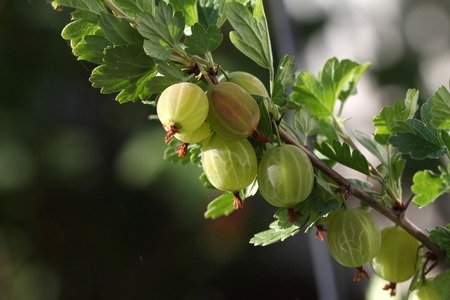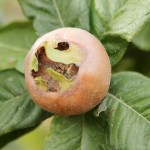
Gooseberries – there little green jewels herald the start in most Summer gardens of the fruit bonanza. Coinciding with blackcurrants, they are often picked for use in desserts, especially fools, jellies and preserves. In fact they lend their tartness to savoury gels extremely well. The fruit freezes brilliantly too.
The bush is really hardy and grows throughout northern climates easily but it does gives its best reward of fruit when given the best care.
Planting And Cultivation
Bare rooted gooseberry bushes are started off in February to march when the worst of winter weather has gone. To reinvigorate bare-root plants leave the roots to soak in a bucket of water for 20 minutes. It helps establish them once these are placed into the ground. Buy the bare rooted bushes from late November to the end of April.
Bushes are planted into well dug and manured ground to start off with. They love rich, moist and slightly acidic soil and the damp conditions in the UK are ideal for this purpose. It is said to be one of the only fruits to grow well though on limestone or other alkaline soils so it is a bit more versatile than given credit for. Plant bushes about 1.2 to 1.5 metres (4 – 5 ft.) apart with a 1.5 to 1.8 metres (5-6ft.) gap between rows.
The ideal time for mulching is throughout the spring generally because keeping the moisture in the soil around the plant is a must. Keep going with the mulching and watering right into early Summer. Do however avoid drenching or heavy watering after a dry spell because like tomatoes, the fruit will swell too quickly and burst and split their skins. It is an issue after heavy thunderstorms and unless they are protected there is little that can be done about this. Watch for disease after these weather periods as split skin leads to molds getting in.
Where Do You Grow ?
Gooseberries grow well in part shade rather than just full sun. Whilst location is everything for many fruit bushes these berries are less choosy. I also plant where I know I can get at the fruit so make sure you have plenty of room to get at the berries from all sides. Prepare a reasonably large hole and fork well-rotted manure into the base. In positioning the plant int the hole, look for the ‘tide mark’ where the lighter and darker parts of the stem meet. This informs you of the height that is needs to be below the ground. Try to keep it at the same level as it was previously grown. Just back-fill into the hole and firm the soil to keep it all in position.
Choose a variety resistant to American mildew if you live in a particularly rainy or damp area and beware the dreaded gooseberry sawfly !
The bushes can be grown as half-standard against walls, stooled or cordoned as with plums although the bush form is generally preferred and can then be pruned to the classic vase shape. The half-standard and cordons are grown on a single rod to form a taller, more upright tree. Bush types are planted at an overall 120cm spacing whilst cordons are placed at least 60cm apart.
Continued Care With Pruning And Thinning
The plants are best pruned and indeed planted in the winter months when other vegetables and fruit remain in their dormancy. It always pays to look after these bushes and to be honest pruning can really occur before any of the twigs burst into leaf. Any weak branches are removed and the remainder need to be reduced by a third so that new growth and shape is promoted. Thinning around half the bush in may or early June will help the remaining fruits to really explode into the ripe and juicy berries we all know and love. Try pruning again around June so that all those pesky side shoots are reduced to five leaves which increases light flow. It also makes it easier to pick the fruits later on without being snagged incessantly by our sleeves.
A balanced fertiliser is fed to the plant during spring but not too much nitrogen should be given as this encourages the plant to become too woody.
Harvesting Gooseberries
Gooseberries are picked always by hand from June to August when they begin to soften slightly and the Sun really lets you know of its presence. I know of some bushes which will start producing ripe fruit by the end of May but just try and resist until the fruit is really sweet. The green fruit is harvested to prepare all sorts of delicious recipes including pies, crumbles and jams. Ripe gooseberries are quite fragile and they will burst if picked too vigorously so be careful. Leaving them as long as possible on the bush means they will simply get sweeter and bursting with flavour but watch for those thrushes and blackbirds who cannot resist them. The fruit should be allowed to ripen fully to red if they are needed for freezing.
The fruit will begin in the second year and once fully established will produce up to 4.5kg (10lb.) fruit per bush for at least 10 years afterwards.
Pests Of Gooseberries
Generally birds are a real nuisance as the fruits ripen. They will pick and peck at the fruits producing holes and ruining the harvest. Bullfinches can take the buds in the winter time and so stunt later fruiting. It is probably best to keep this fruit in cages or covered extremely well with netting during the summer. I have tried scare devices but these are not so effective as thought.
Gooseberry mildew is a fungal disease. It is encouraged by a lack of air circulation. best avoided by making sure air circulation is optimal and this fundamentally depends on the spacing between the bushes. Likewise, good effective pruning and choosing resistant varieties will help as we discuss later. The mildew makes itself known by a greyish-white powdery layer on the leaves and stems. It will also form a felt-like coating on the fruit. If you are blighted by blight then remove all affected leaves and stems and dispose of but not in the compost. Prune the rest of the bush to improve air circulation.
The Gooseberry Sawfly
The Gooseberry sawfly is active in late May and June. The tiny caterpillar makes its unwanted presence felt by chomping leaves in a successive manner. The larvae will strip off all the leaves in a few days. It apparently eats its own body weight twice in a day, so handpick to remove the pest. Just inspect the underside of leaves regularly from mid-late spring onwards.
Fortunately it only weakens the plant and doesn’t affect the crop like mildew does. The sawfly appears in various generations throughout the year so always be vigilant. Avoid sprays where feasible although drastic measures may be needed to remove it but do not pick fruit for at least a month once sprayed. Spraying nematodes will also serve as a biological control.
Cultivars Of Gooseberries
The heritage varieties are always worth considering simply because of their longevity as well as their propensity for good quality fruit. Many of the old varieties are mildew prone which is why they have slowly fallen out of favour although they beginning to make a comeback. One of the earliest was ‘Langley Gage‘ which was bred in 1824 and may well be the sweetest berry ever. An absolute must for the dessert table in its own right. The small, slightly silvery-white fruit is still one of the best.
The variety ‘Careless‘ became available in the mid 1800s and was much admired for its huge crops of pale green fruit. These become lighter with ripening which makes it ideal for cooking and jam manufacture because of its pale colour. Another slightly yellow-amber fruiting variety of great age is ‘Yellow Champagne’ with its somewhat hairy countenance. Still a fine and flavoursome variety. ‘Leveller’ appears in 1851 with its large luscious yellow-green fruit and fine flavour. It isn’t as widely grown as it could be because of its susceptibility to mildew but it has to be its dessert flavour that sets it apart from the rest.
If you like red heritage varieties than look for ‘Lancashire Lad‘ which produces great flavour and is a great favourite with the soft fruit growers. We also think ‘Whinhams Industry’ bred in 1835 produces good yields and is ideal for heavy soils – it produces its red fruit on ripening. Apparently one of the last ones to do so.
‘Invicta’ is a very good fruit producer and cropper (twice the yield of most), a famous standard and resistant to Mildew. It is the most widely grown of all the dessert/culinary fruit. Produces lush green fruits from June to July. The fruit is ideal when cooked but also sweet enough to be eaten raw when really ripe. The bush is compact and vigorous. The fruit ripens from early July onwards.
Another highly resistant variety is ‘Captivator‘. This variety is probably the best dessert variety we can get our hands on. Almost thornless but not quite. Produces red burgundy fruits on a bush which has a vigorous spreading habit.
Look for the modern day Hinnonmaki series which are all bred in Finland and highly resistant to mildew especially American Mildew.
The variety ‘Hinnonmaki Yellow’ is extremely hardy and is as you’ve guessed – yellow-green. The variety has a unique flavour similar to a gooseberry but with a slight aromatic apricot note. It is a mid-season variety (ripens from July onwards) which is also a good cropper. What about ‘Hinnonmaki Green‘ which is similar to the yellow variety but produces a green fruit. This particular variety needs cooking because of its tart taste. Likewise, ‘Hinnonmaki Red ‘ produces attractive wine-red fruit with a more sweet and tangy flavour than some of the other Finnish varieties.
Modern day varieties include ‘Xenia‘ which produces heavy red fruit and has a quality that makes it ideal for straight dessert without any cooking. We also like ‘Martlet‘ which has good mildew resistance and a fine sweet flavour that rivals the heritage varieties.
Remember there are numerous other berry fruits to choose from including redcurrants, blackcurrants, raspberries and strawberries too which enhance the fruit garden.
Buy From:-
DT Brown T: 0044 3330 030 869 www.dtbrownseeds.co.uk
Pennard Plants www.pennardplants.com
Ken Muir T: 01255 830 181 www.kenmuir.co.uk
Get bare rooted plants from Dobies too.
Please note this page contains links to our affiliate marketing partner. Please read our affiliate disclosure.



I’ve been immensely disappointed with shop bought gooseberries. I then started growing my own and they were just fantastic. I bough bare root plants and placed them under an old apple tree where they still get plenty of light.My biggest issue is gooseberry sawfly. Best variety has to be Invicta in my book.
Thanks for the information. I am buying bare rooted bushes from Dobies.